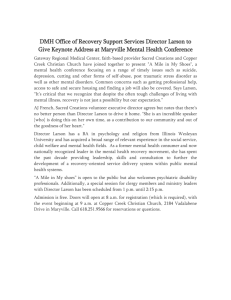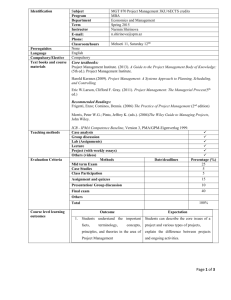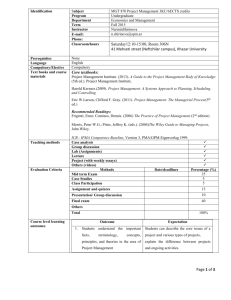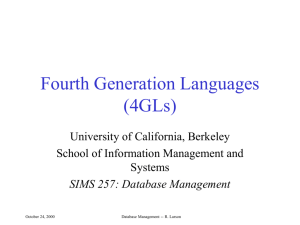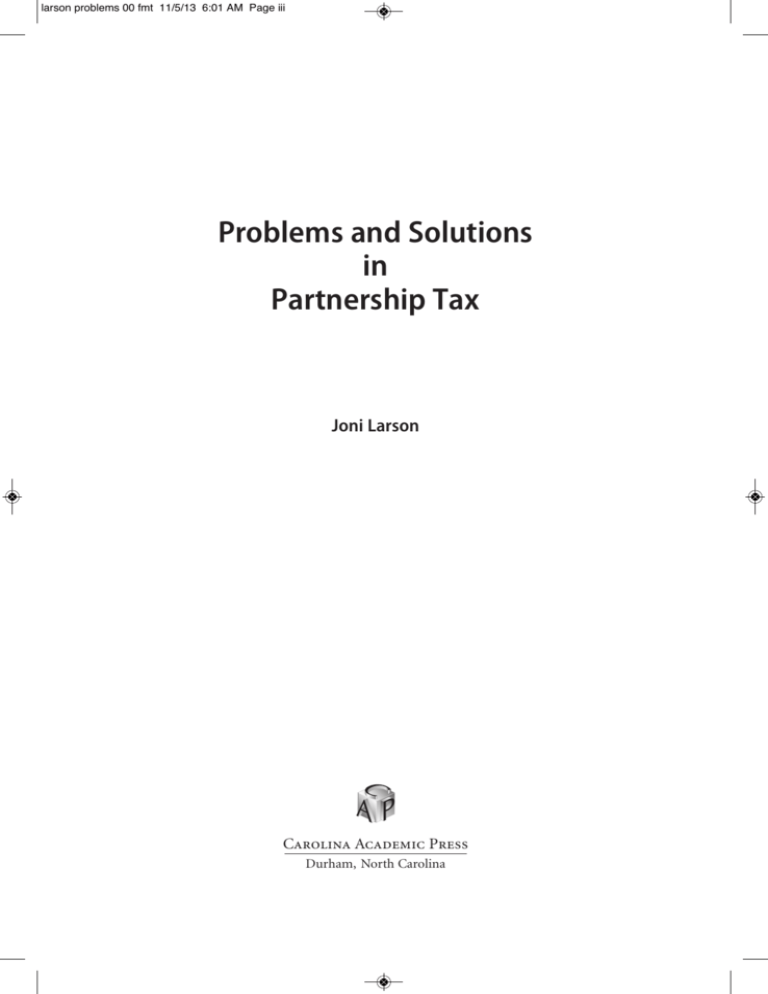
larson problems 00 fmt 11/5/13 6:01 AM Page iii
Problems and Solutions
in
Partnership Tax
Joni Larson
Carolina Academic Press
Durham, North Carolina
larson problems 00 fmt 11/5/13 6:01 AM Page iv
Copyright © 2014
Joni Larson
All Rights Reserved
Library of Congress Cataloging-in-Publication Data
Larson, Joni.
Problems and solutions in partnership tax / Joni Larson.
pages cm
Includes bibliographical references and index.
ISBN 978-1-61163-491-4 (alk. paper)
1. Partnership--Taxation--United States. I. Title.
KF6452.L375 2013
343.7306'62--dc23
2013025646
Carolina Academic Press
700 Kent Street
Durham, NC 27701
Telephone (919) 489-7486
Fax (919) 493-5668
www.cap-press.com
Printed in the United States of America
larson problems 00 fmt 11/5/13 6:01 AM Page v
Contents
Introduction
ix
Chapter I.
3
3
3
4
5
7
7
10
12
13
15
Chapter II.
23
23
Formation of a Partnership
A. Requirements for Tax-Free Transaction
1. Special Rules
2. Failing Tax-Free Status
B. Basis
C. Holding Period
D. Partnership Interest Received in Exchange for Services
E. Partnership Balance Sheet
Summary
Questions
Solutions
Partnership Debt — The Basics
A. Definition of Liability
B. Capital Accounts and Obligation of Partners to Partnership to Make
Capital Contributions
C. Effect of Liabilities
D. Determination of Partner’s Share of Recourse Liability
E. Determination of Partner’s Share of Non-Recourse Liability
F. Effect on Balance Sheet
Summary
Questions
Solutions
Chapter III.
Operating Provisions
A. Partnership Return
B. Taxable Year
C. Computation of Taxable Income
D. Start-Up Costs
E. Allocation of Partnership Items
F. Varying Interests in the Partnership
v
23
24
24
26
26
27
29
31
41
41
42
44
45
47
48
larson problems 00 fmt 11/5/13 6:01 AM Page vi
vi
CONTENTS
G. Limitation of Losses
Summary
Questions
Solutions
49
50
52
55
Chapter IV.
65
65
66
67
67
68
69
70
71
71
72
72
77
79
81
87
Chapter V.
111
111
112
113
114
114
115
115
118
119
120
120
122
123
126
Chapter VI.
149
149
151
154
156
159
Chapter VII.
177
177
177
Special Rules Relating to Allocations
A. Allocation of Recourse Deductions
1. Economic Effect
a. General Test for Economic Effect
b. Alternate Test for Economic Effect
c. Failure to Meet General or Alternate Test
2. Substantiality
3. Areas of Special Concern
B. Allocation of Non-Recourse Deductions
1. Relevance of Tufts, or Phantom, Gain
2. Safe Harbor Requirements
a. Underlying Concepts
b. Safe Harbor Requirements
Summary
Questions
Solutions
Allocations Deemed to Have Economic Effect
A. Allocation of Depreciation
1. General Rule
2. Ceiling Rule
a. Traditional Method with Curative Allocations
b. Remedial Allocations
B. Allocations Related to Sale of Contributed Property
1. General Rule
2. Ceiling Rule
a. Traditional Method with Curative Allocations
b. Remedial Method
3. Characterization Issues
Summary
Questions
Solutions
Effect of Liabilities — Revisited
A. Allocation of Recourse Liabilities
B. Allocation of Non-Recourse Liabilities
Summary
Questions
Solutions
Transfer of a Partnership Interest
A. Tax Consequences to the Transferring Partner
1. General Rule
larson problems 00 fmt 11/5/13 6:01 AM Page vii
CONTENTS
2. Exceptions to the General Rule
a. Hot Assets
b. Lukewarm Assets
3. Allocation of Basis and Holding Period
4. Sale Using the Installment Method
5. Death of a Partner
B. Tax Consequences to the Buying Partner
1. General Rule
2. Exception to the General Rule
Summary
Questions
Solutions
Chapter VIII.
Non-Liquidating Distributions from the Partnership to a Partner —
General Rules
A. Non-Liquidating Distribution of Cash
B. Non-Liquidating Distribution of Property
1. Non-Liquidating Distribution of More Than One Property
2. Distributee Partner’s Election
3. Distribution of Marketable Securities
C. Ordering Rules
D. Characterization of Subsequent Disposition of Property Distributed
to a Partner
E. Partnership Election
Summary
Questions
Solutions
vii
178
178
179
180
180
181
182
182
182
186
188
191
211
211
212
213
214
214
215
215
216
220
221
223
Chapter IX.
233
233
234
239
240
241
Chapter X.
249
249
Disproportionate Distributions
A. Rationale
B. Steps to Restructure the Transaction
Summary
Problems
Solutions
Mixing Bowl Transactions
A. Distribution of Previously Contributed Property
B. Distribution of Other Property to Partner Who Had Contributed
Property — General Rule
Summary
Problems
Solutions
Chapter XI.
Liquidating Distributions
A. Payments for Partner’s Interest in Partnership Property (Section 736(b))
B. Other Payments (Section 736(a))
C. Allocation of Installment Payments
Summary
Questions
251
253
254
256
265
265
267
268
269
270
larson problems 00 fmt 11/5/13 6:01 AM Page viii
viii
CONTENTS
Solutions
272
Chapter XII.
275
275
275
276
276
277
277
277
278
279
279
281
283
284
285
Chapter XIII.
289
290
291
292
Transactions in Capacity Other Than as a Partner
A. Compensation for Services, Rent, Interest
1. Services
2. Rental of Property
3. Use of Money
4. Limitation
B. Transfer of property
1. Disposition of Property
2. Limitation
3. Characterization Issues
C. Need for Making Determination
D. Determining in Which Capacity a Partner Is Acting
Summary
Questions
Solutions
Guaranteed Payments
Summary
Questions
Solutions
larson problems 00 fmt 11/5/13 6:01 AM Page ix
Introduction
Partnership taxation is often considered one of the most difficult areas of tax. However,
given the growing number of limited liabilities companies (which generally are taxed
as partnerships for tax purposes), it is extremely beneficial to have a working knowledge
of this area. In addition, partnership tax provides a flexibility found nowhere else in
the Code, affording the attorney or accountant an unparalleled opportunity to engage
in tax planning on behalf of his client.
In approaching partnership tax, it is helpful to understand a few basic concepts.
First, a partnership is a “flow-through” entity. It does not pay any tax. Rather, the
taxable items flow through the partnership and are reported by the partners. Second,
in designing the flow-through system, Congress was not always consistent in its treatment
of the status of the partnership. Sometimes it is respected as an entity, separate and
distinct from its partners. At other times, the entity is ignored and instead the arrangement
is treated as an aggregation of the partners. And, finally, at other times, a hybrid approach
is used.
The chapters that follow organize the partnership tax concepts and provisions into
cohesive groups. However, one of the things that makes partnership tax so difficult is
that the provisions are often interrelated and intertwined. In some respects, it is only
after the entire area has been studied that the overall system will make sense. As a result,
trying to fit the pieces together along the way can feel a bit like putting together a puzzle
without having seen the picture. But, once the pieces are in place, the overall picture
does make sense. And then, planning can begin.
ix

